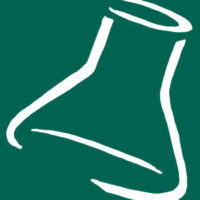Salmonella spp. are the leading cause of foodborne bacterial diseases in many countries. This reality stems from the ubiquity of the microorganism in the natural environment, its prominence in various sectors of the agriculture industry and from the escalating movement of food and food ingredients in international trade. Although salmonellae remain well entrenched in the meat and poultry industries, fresh fruits and vegetables, including sprouts, oranges and tomatoes, have emerged in recent years as important vehicles of human salmonellosis.
In addition, the notoriety of Salmonella enteritidis as a pandemic serovar persists but is being challenged by the pentaresistant (ACSSuT) Salmonella Typhimurium DT104, which is progressively acquiring additional resistance to ciprofloxacin and trimethoprim. The widespread agricultural use of antibiotics for prophylaxis, growth promotion and therapy and its impact on the emergence and persistence of Salmonella and other foodborne bacterial pathogens that are resistant to medically important antimicrobials is disquieting. Of great concern is the expansive use of quinolones in agriculture and aquaculture, which contributes to the progressive erosion of these drugs for the effective treatment of systemic Salmonella infections. The propensity of few Salmonella cells to trigger enterocolitic symptoms and to engender chronic arthopathies underscore the need for effective control measures at all levels of the food production, processing, distribution and marketing continuum.
A Continuing Public Health Concern
The genus Salmonella consists of more than 2,463 serovars that are classified within two species: Salmonella enterica and Salmonella bongori.[1] All serovars are potentially pathogenic to humans. Non-typhoid and non-paratyphoid strains of salmonellae generally engender enterocolitis, a self-limiting disease that may include diarrhea, severe abdominal pain, nausea, vomiting and fever. The clinical management of enterocolitis should be limited to fluid and electrolyte replacement because antibiotic therapy tends to prolong the convalescent carrier states.[2]
However, enterocolitis can degenerate into more serious systemic infections that require aggressive antimicrobial therapy. Non-typhoid Salmonella infections can also lead to chronic arthopathies that may appear shortly or belatedly after the acute phase of salmonellosis. The involvement of the human leucocyte antigen (HLA) B27 as a predisposing human genetic factor in the development of chronic arthopathies remains a controversial topic.[3] Enteric fever is a serious clinical condition resulting from an exposure to S. typhi or S. paratyphi, which readily translocate from the intestinal tract into deep human host tissues. The symptomology of this disease differs from non-typhoid salmonellosis in its longer period of incubation, prolonged fever, frequent absence of diarrhea and characteristic systemic invasion of the host. The disease can lead to a chronic carrier state during which asymptomatic carriers intermittently shed salmonellae.[3,4]
The increasing prevalence of Salmonella that are resistant to ampicillin, chloramphenicol and trimethoprim sulfamethoxazole, once the mainstay of therapy for human systemic salmonellosis, has severely undermined the efficacy of these drugs in many countries. Although third-generation cephalosporins and fluoroquinolones are currently recognized as effective therapeutic alternatives, increasing reports on the occurrence of quinolone-resistant Salmonella in human medicine and in the global food chain are of significant public health concern.
Pandemic Serovars of Concern
Two pandemic serovars, S. Enteritidis and S. Typhimurium DT104, are currently circulating in the global food chain. Marked increases in the number of foodborne outbreaks of S. Enteritidis were first reported in the United Kingdom in the mid-1980s. Epidemiological investigations rapidly established a link between human illness and the consumption of fresh shell eggs and egg products. The eggborne S. Enteritidis presents a unique public health problem because of its transovarian transmission and localization within the egg magma S. Enteritidis infection of the ovum or oviduct in the hen’s reproductive tract leads, respectively, to vitelline membrane and albumen contamination in intact shell eggs.5 Commercial egg sanitizing practices that target the surface decontamination of fresh shell eggs are therefore ineffective in eliminating internal contamination with S. Enteritidis.
Concerted efforts by government agencies and the egg industry to control this eggborne pathogen through on-farm interventions have met with some success as evidenced by recent reports of marked decreases in the incidence of human S. Enteritidis infections in the United Kingdom and the United States.[6,7] Nonetheless, this serovar remains well entrenched in the broiler industry and figures prominently as the leading cause of foodborne salmonellosis in many developed and developing countries.[2,6,8]
S. Typhimurium phage-type 104 first gained notoriety in the early 1990s because of its increasing prevalence in various food-producing sectors and, more importantly, its common carriage of chromosomally-encoded resistance to five antibiotics used in human medicine.[9] In addition to its general lack of sensitivity to ampicillin, chloramphenicol, streptomycin, sulfonamides and tetracycline (R-type ACSSuT), recent reports indicate that the pentaresistant DT104 biotype is also acquiring resistance to trimethoprim and quinolones.[10] Reported decreases in the number of DT104 infections in humans in England and Wales and in meat animals in the United States in the last few years are encouraging.[11,12]
Overview of Recent Foodborne Illness Outbreaks
Salmonella spp. remains the leading cause of foodborne bacterial diseases in many countries.[2] The prominence of raw meats as major vehicles of human salmonellosis stems in part from the ubiquity of the pathogen in the natural environment, the use of intense husbandry practices in the meat and poultry industries, the general lack of Salmonella-free poultry replacement stocks, the widespread occurrence of salmonellae in animal feeds and the massive throughput in meat slaughtering operations.[2]
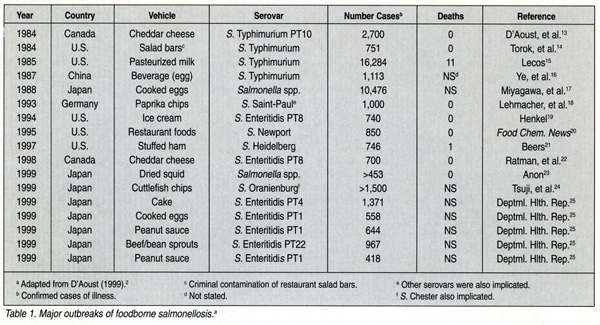 Major outbreaks of foodborne salmonellosis in the last two decades have involved a wide variety of foods and serovars (Table 1). In 1984, cheddar cheese manufactured from pasteurized and heat-treated (non-pasteurized) bovine milk was incriminated as the source of 2,700 cases of human salmonellosis. Plant investigations suggested that the manual override of a flow diversion valve resulted in the mixing of raw and thermally processed cheese milk. In the largest recorded Salmonella outbreak in the United States, a cross-connection between raw and pasteurized milk lines allegedly triggered this incident. The consumption of cold beverages prepared with raw eggs in the People’s Republic of china (1987) and of cooked eggs in the city of Hokkaido, Japan (1988) led to numerous cases of human illness. In 1993, potato chips sprinkled with contaminated paprika imported from South America were incriminated as the cause of an outbreak of S. Saint-Paul, S. Rubislaw and S. Javiana in Germany. In the following year, a multistate episode of human S. enteritidis PT8 infections in the U.S. was attributed to ice cream. Investigations revealed that tanker trucks that had hauled raw liquid eggs were not properly sanitized before loading pasteurized premix destined for the ice cream manufacturing plant. In 1995- 1997, the cross-contamination of foods with raw poultry in a Florida restaurant and the inadequate cooking of stuffed ham at a church dinner in Maryland resulted in major outbreaks of salmonellosis. In 1998, cheddar cheese used in the preparation of commercial lunch packs was identified as the vehicle of infection in a Canadian episode of human S. Typhimurium PT8 infections. In 1999, dried squid and cuttlefish chips were incriminated in outbreaks of salmonellosis in Japan whereas different phagetypes of S. Enteritidis accounted for five additional foodborne outbreaks.
Major outbreaks of foodborne salmonellosis in the last two decades have involved a wide variety of foods and serovars (Table 1). In 1984, cheddar cheese manufactured from pasteurized and heat-treated (non-pasteurized) bovine milk was incriminated as the source of 2,700 cases of human salmonellosis. Plant investigations suggested that the manual override of a flow diversion valve resulted in the mixing of raw and thermally processed cheese milk. In the largest recorded Salmonella outbreak in the United States, a cross-connection between raw and pasteurized milk lines allegedly triggered this incident. The consumption of cold beverages prepared with raw eggs in the People’s Republic of china (1987) and of cooked eggs in the city of Hokkaido, Japan (1988) led to numerous cases of human illness. In 1993, potato chips sprinkled with contaminated paprika imported from South America were incriminated as the cause of an outbreak of S. Saint-Paul, S. Rubislaw and S. Javiana in Germany. In the following year, a multistate episode of human S. enteritidis PT8 infections in the U.S. was attributed to ice cream. Investigations revealed that tanker trucks that had hauled raw liquid eggs were not properly sanitized before loading pasteurized premix destined for the ice cream manufacturing plant. In 1995- 1997, the cross-contamination of foods with raw poultry in a Florida restaurant and the inadequate cooking of stuffed ham at a church dinner in Maryland resulted in major outbreaks of salmonellosis. In 1998, cheddar cheese used in the preparation of commercial lunch packs was identified as the vehicle of infection in a Canadian episode of human S. Typhimurium PT8 infections. In 1999, dried squid and cuttlefish chips were incriminated in outbreaks of salmonellosis in Japan whereas different phagetypes of S. Enteritidis accounted for five additional foodborne outbreaks.
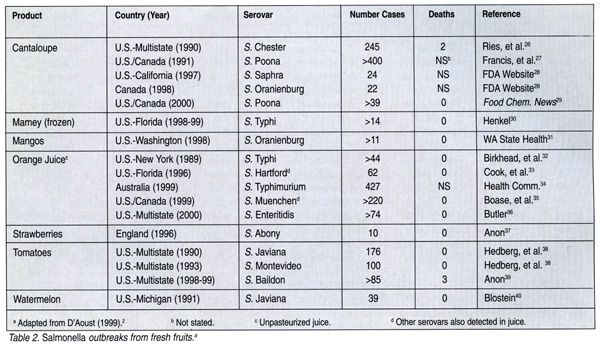
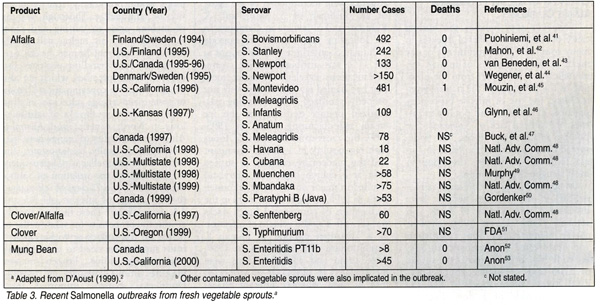 Recent reports of national and international incidents of salmonellosis associated with fresh fruits (Table 2) and vegetables (Table 3) are disquieting. Human illness from the consumption of fresh cantaloupes and watermelon likely resulted from the transfer of salmonellae from the external surface of melons onto edible tissues during slicing. Subsequent display or storage of cut melon at ambient temperature together with the high water activity and sugar content of these foods would promote a rapid proliferation of salmonellae. Thorough washing of melons prior to cutting and rapid refrigeration of cut melon will greatly reduce the inherent human health risk. These safe food handling practices also apply to fresh tomatoes, which are also prone to surface contamination.[54] Fresh, unpasteurized orange juice was incriminated in several outbreaks of salmonellosis in North America and Australia. Although the acidity of orange juice (pH 3.4-4.0) is generally bacteriostatic, the survival of salmonellae is pH-dependent as indicated by the isolation of salmonellae after 27 and 73 days of refrigerated (0-4°C) storage of juice at pH 3.5 and 4.4, respectively.[55] These findings together with the propensity for salmonellae to persist on the surface or within washed fruits support the need to pasteurize all fresh orange juice. Frozen mamey imported from Guatemala and possibly Honduras, mangos imported from Mexico and strawberries of unstated origin were also incriminated in recent outbreaks of human salmonellosis.
Recent reports of national and international incidents of salmonellosis associated with fresh fruits (Table 2) and vegetables (Table 3) are disquieting. Human illness from the consumption of fresh cantaloupes and watermelon likely resulted from the transfer of salmonellae from the external surface of melons onto edible tissues during slicing. Subsequent display or storage of cut melon at ambient temperature together with the high water activity and sugar content of these foods would promote a rapid proliferation of salmonellae. Thorough washing of melons prior to cutting and rapid refrigeration of cut melon will greatly reduce the inherent human health risk. These safe food handling practices also apply to fresh tomatoes, which are also prone to surface contamination.[54] Fresh, unpasteurized orange juice was incriminated in several outbreaks of salmonellosis in North America and Australia. Although the acidity of orange juice (pH 3.4-4.0) is generally bacteriostatic, the survival of salmonellae is pH-dependent as indicated by the isolation of salmonellae after 27 and 73 days of refrigerated (0-4°C) storage of juice at pH 3.5 and 4.4, respectively.[55] These findings together with the propensity for salmonellae to persist on the surface or within washed fruits support the need to pasteurize all fresh orange juice. Frozen mamey imported from Guatemala and possibly Honduras, mangos imported from Mexico and strawberries of unstated origin were also incriminated in recent outbreaks of human salmonellosis.
Fresh ready-to-eat vegetable sprouts figured prominently in recent years as vehicles of Salmonella infection (Table 3). In the last six years, the consumption of alfalfa sprouts resulted in at least four international and eight national outbreaks of salmonellosis. Four additional disease incidents in North America were attributed to a mixture of clover/alfalfa, clover and mung bean sprouts. It is widely held that contaminated seeds were responsible for the foregoing episodes. The reported difficulties in recovering salmonellae from untreated seeds using standard culture procedures suggests that the pathogen is entrapped beneath the seed coat thereby undermining the efficacy of hypochlorite (20,000 ppm) disinfection of seeds. The high water activity, nutrient availability and the time/temperature regimens associated with seed germination offer optimal conditions for the rapid growth of cryptic Salmonella survivors. Although hypochlorite and the implementation of Hazard Analysis & Critical Control Points (HACCP) programs are finding increased application within the sprout industry, the testing of spent irrigation waters and finished sprouts for bacterial pathogens is viewed as a key determinant of product safety. The use of gamma irradiation, ozonated water, organic acids, heat, competitive exclusion microflora and novel sanitizers are currently under consideration as possible intervention strategies for ≥ 5 log10 reduction of pathogens in sprouting seeds.
Fresh fruits and vegetables therefore present a unique public health challenge because they are frequently consumed without further processing to eliminate Salmonella spp., which readily survive and even grow at refrigerator temperatures.[2] The enhanced safety of fresh produce is predicated by the hygienic harvesting of crops, the use of chlorinated wash water and ice made from potable water, the regular sanitizing of on-farm and in-plant equipment, and the introduction of barriers to reduce potential cross-contamination during processing and within the wholesale/retail chain of distribution.
The Impact of Antibiotics
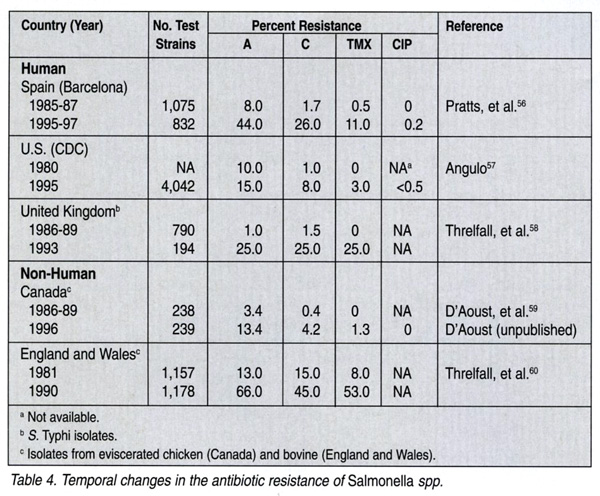 The widespread use and abuse of first- line antibiotics including ampicillin (A), chloramphenicol (C) and trimethoprim sulfamethoxazole (TMX) in developing countries has compromised their therapeutic efficacy in the clinical management of typhoid, paratyphoid and systemic non-typhoid infections.[2] Increasing resistance of human and non-human Salmonella to first-line antibiotics in developed countries is also of major concern (Table 4). This situation has led to a shift to cephalosporins and fluoroquinolones for the treatment of serious cases of human salmonellosis. However, recent isolation of ciprofloxacin (CIP)resistant salmonellae augurs poorly for the future and raises the specter of possible cross-resistance whereby strains that acquire resistance to ciprofloxacin may also develop resistance to other quinolones.[2,10]
The widespread use and abuse of first- line antibiotics including ampicillin (A), chloramphenicol (C) and trimethoprim sulfamethoxazole (TMX) in developing countries has compromised their therapeutic efficacy in the clinical management of typhoid, paratyphoid and systemic non-typhoid infections.[2] Increasing resistance of human and non-human Salmonella to first-line antibiotics in developed countries is also of major concern (Table 4). This situation has led to a shift to cephalosporins and fluoroquinolones for the treatment of serious cases of human salmonellosis. However, recent isolation of ciprofloxacin (CIP)resistant salmonellae augurs poorly for the future and raises the specter of possible cross-resistance whereby strains that acquire resistance to ciprofloxacin may also develop resistance to other quinolones.[2,10]
The massive use of antibiotics in the agriculture and aquaculture industries undoubtedly supports the increasing prevalence of multiple antibiotic-resistant salmonellae in the global food chain.[3] The addition of subtherapeutic doses of antibiotics in animal feeds for prophylaxis and growth promotion selects and maintains populations of resistant bacterial pathogens. The propensity for intra- and inter-generic transfer of resistance plasmids, the presence of multiple resistance loci on a single plasmid, and the linkage of resistance and virulence determinants on a common plasmid further heightens public health concerns.[2,3]
Evidence that the use of non-medical drugs such as apramycin, tylosin, avoparcin and virginiamycin in the meat animal husbandry industry favors the emergence of bacteria resistant to the human drugs gentamycin, erythromycin, vancomycin and pristinamycin, respectively, underlines the pressing need to reconsider antibiotic use in agriculture and aquaculture in terms of veterinary requirements and human health impact. Moreover, the escalating use of fluoroquinolones in meat animal husbandry in Europe and North America is not prudent and needs to be restricted to safeguard their human therapeutic value.
Jean-Yves D’Aoust is a senior research scientist with the Health Products and Food Branch, Sir F.G. Banting Research Center, of Health Canada in Ottawa, Ontario. He has been responsible for the departmental research program on Salmonella in foods for nearly three decades, and enjoys an enviable national and international reputation as a leading expert in his research field of endeavor. D’Aoust is frequently called upon by government agencies, food trade organizations, international bodies such as the World Health Organization, the Food and Agriculture Organization (FAO) of the United Nations, and International Organization for Standardization (ISO) for expert advice on Salmonella in relation to the formulation of food safety policies, the development of guidelines and standards, food-specific risk assessments, and reliability of traditional and novel methods for the detection of foodborne salmonellae. ??*Presented at the Second NSF International Conference on Food Safety, October 11-13, 2000, Savannah, GA. ??
References
1. Popoff, M.-Y., J. Bockemuhl and F.W. Brenner. Supplement 1998 (No. 42) to the Kauffman-White scheme. Res. Microbiol, 151, pp. 63-65. 2000.
2. D’Aoust, J.-Y. Salmonella. In: The Microbiological Safety and Quality of Food. B.M. Lund, A.C. Baird-Parker and G.W. Gould, eds. Aspen Publishers. Gaithersburg, MD. Chapter 45, pp. 1233-1299. 1999.
3. D’Aoust, J.-Y. Salmonella species. In: Food Microbiology: Fundamentals and Frontiers. M.P. Doyle, L.R. Beuchat and T.J. Montville, eds. ASM Press. Washington, DC. Chapter 8, pp. 129-158. 1997.
4. D’Aoust, J.-Y. Pathogenicity of foodborne Salmonella. Int. J. Food. Microbiol., 12, pp. 17-40. 1991.
5. Duguid, J.P. and R.A.E. North. Eggs and Salmonella food poisoning: an evaluation. Med. Microbiol., 34, pp. 65-72. 1991.
6. Ward, L.R., et al. Salmonella Enteritidis epidemic. Science 287, pp. 1753-1754. 2000.
7. Anon. Briefs. Food Chem. News, 41(51). Feb. 7, 2000.
8. D’Aoust, J.-Y. Salmonella spp. in the global food trade. Med. J. Indonesia, 7, pp. 125-131. 1998.
9. Baggesen, DL., D. Sandvang and F.M. Aarestrup. Characterization of Salmonella enterica serovar Typhimurium DT1 04 isolated from Denmark and comparison with isolates from Europe and the United States. J. Clin. Microbiol., 38, pp. 1581 -1 586. 2000.
10. Threlfall, E.J., F.J. Angulo and RG. Wall. Ciprotloxacin-resistant Salmonella Typhimurium DT1O4. Vet. Res., 142(10), p. 255. 1998.
11. Anon. Salmonella Typhimurium infections in humans. Comm. Dis. Rep. 10(15), p. 13. 2000.
12. Besser, T.E., et al. Multiresistant Salmonella Typhimurium DT1O4 infections of humans and domestic animals in the Pacific Northwest of the United States. Epidemiol. Infect., 124, pp. 193- 200. 2000.
13. D’Aoust, J.-Y., et al. Salmonella Typhimurium phage-type 10 from cheddar cheese implicated in a major Canadian foodborne outbreak. J. Food Prot., 48(12), pp. 1062-1066. 1985.
14. Torok, T.J., et al. A large community outbreak of salmonellosis caused by intentional contamination of restaurant salad bars. J. Am. Med. Assoc., 278(5), pp. 389-395. 1997.
15. Lecos, C. Of microbes and milk: probing America’s worst Salmonella outbreak. Daily and Food Sanitation, 6(4), pp. 136-140. 1986.
16. Ye, XL., et al. An outbreak of food poisoning due to Salmonella Typhimurium in the People’s Republic of China. J. Diarrh. Dis. Res., 8(3), pp. 97-98. 1990. 17. Miyagawa, S. and A. Miki. Food poisoning occurrences (1991). Food Sanit. Res., 42, pp. 78-1 04. 1992.
18. Lehmacher, A., et al. Nationwide outbreak of human salmonellosis in Germany due to contaminated paprika and paprika-powdered potato chips. Epidemiol. Infect., 115, pp. 501-511. 1995.
19. Henkel, J. Ice cream firm linked to Salmonella outbreak. FDA Consumer 33(5), pp. 30-31. 1995.
20. Anon. Florida Salmonella outbreak caused changes in state inspections. Food Chem. News, 37(28). 1995.
21. Beers, A. Maryland church dinner Salmonella outbreak blamed on faulty food preparation. Food Chem. News, 39(41), pp. 19-20. 1997.
22. Ratman, S., et al. Salmonella Enteritidis outbreak due to contaminated cheese— Newfoundland. Canada Comm. Dis. Rep., 25(3), pp. 17-20. 1999.
23. Anon. Salmonellosis, dried squid—Japan (Tokyo). Mainichi Daily News. April 25, 1999.
24. Tsuji, H. and K. Hamada. Outbreak of salmonellosis caused by ingestion of cuttlefish chips contaminated by both Salmonella Chester and Salmonella Oranienburg. Jpn. J. Infec. Dis., 52, pp. 138-139. 1999.
25. Ministry of Health and Welfare, Japan. Departmental Health Report. 1999.
26. Ries, A.A., et al. A multistate outbreak of Salmonella Chester linked to imported cantaloupe (abstract). Interscience Conference on Antimicrobial Agents and Chemotherapy. Washington, DC. 1990.
27. Francis, B.J., et al. Multistate outbreak of Salmonella Poona infections—United States and Canada. Morb. Mortal. Wkly Rep., 40(32), pp. 549-552. 1991.
28. U.S. Food and Drug Administration Website. Produce safety at retail: sate handling practices for melons. June 8, 2000. (www.fda.gov).
29. Anon. California state health officials.... Food Chem. News, 42(16), p. 12. 2000.
30. Henkel, J. Imported fruit blamed for rare typhoid outbreak. FDA Consumer, 33(4), pp. 36-37. 1999.
31. Washington State Health Department. Salmonella Oranienburg outbreak from imported mangoes. Internal communication. July 1998.
32. Birkhead, G.S., et al. Typhoid fever at a resort hotel in New York: a large outbreak with an unusual vehicle. J. Infect. Dis., 167, pp. 1228-1232. 1993.
33. Cook, K.A., et al. Outbreak of Salmonella serotype Hartford infections associated with unpasteurized orange juice. J. Am. Med. Assoc., 280(17), pp. 1604-1509. 1998.
34. South Australian Health Commission. End to Salmonella outbreak. Press release (Adelaide). March 25, 1999.
35. Boase, J., et al. Outbreak of Salmonella serotype Muenchen infections associated with unpasteurized orange juice-United States and Canada, June 1999. J. Am. Med. Assoc., 282(8), pp. 726-728. 1999.
36. Butler, M.A. Salmonella outbreak leads to juice recall in western states. Food Chem. News, 42(10), pp. 19-20. 2000.
37. Anon. General outbreaks of foodborne illness. Comm. Dis. Rep., 6(32). 1996.
38. Hedberg, C.W., et al. Outbreaks of salmonellosis associated with eating uncooked tomatoes: implications tor public health. Epidemiol. Infect., 122, pp. 385-393. 1999.
39. Anon. Food Chem. News. 41(33), p. 39. 1999.
40. Blostein, J. An outbreak of Salmonella Javiania associated with consumption of watermelon. J. Environ. 1-11th., 56(1), pp. 29-31. 1993.
41. Puohiniemi, A.. et al. Molecular epidemiology of two international sprout-borne Salmonella outbreaks. J. Clin. Microbiol., 35, pp. 2487-2491. 1997.
42. Mahon, B.E., et al. An international outbreak of Salmonella infections caused by alfalfa sprouts grown from contaminated seeds. J. Infect. Dis., 175, pp. 876-882. 1997.
43. van Beneden, C.A., et al. Multinational outbreak of Salmonella enterica serotype Newport infections due to contamination alfalfa sprouts. J. Am. Med. Assoc., 281, pp. 158-1 62. 1999.
44. Wegener, H.C., et al. An outbreak of human salmonellosis in Denmark caused by alfalfa sprouts. Proceedings of Salmonella and Salmonellosis, pp. 587-589. Ploufragan, France. May 1997.
45. Mouzin, F., et al. When a health food becomes a hazard: a large outbreak of salmonellosis associated with alfalfa sprouts. California Epidemic Intelligence Service Conference. Centers for Disease Control and Prevention. Atlanta, GA. April 1997.
46. Glynn, M.K., et al. When health food isn’t so healthy-an outbreak of Salmonella serotypes Anatum and Intfantis associated with eating contaminated sprouts, Kansas and Missouri, 1997. Epidemic Intelligence Service Conference. Centers for Disease Control and Prevention. Atlanta, GA. April 1997.
47. Buck, P., et al. Would you like a little Salmonella with your sandwich? Epidemic Intelligence Service Conference. Centers for Disease Control and Prevention. Atlanta, GA. April 1998.
48. National Advisory Committee on Microbiological Criteria for Foods. Microbiological safety evaluations and recommendations on sprouted seeds. mt. J. Food Microbiol., 52, pp. 123-153. 1999.
49. Murphy, J. Wisconsin Salmonella outbreak may be tied to L.A. cases. Food Chem. News, 41(45), p.6. 1999.
50. Gordenker, A. Common seed source identified in Canadian outbreak. Food Chem. News, 41(34), p.23. 1999.
51. U.S. FDA. Consumers advised of risks associated with raw sprouts. HHS News (P99-i 3). U.S. Department of Health and Human Services. July 1999.
52. Anon. S. Enteritidis PT11b-Calgary and Saskatoon. Internal communication. Health Canada. June 2000.
53. Anon. Salmonellosis outbreak associated with raw mung bean sprouts. News Release (22-00). California Department of Health Services. April 2000.
54. Lin, C. and C. Wei. Transfer of Salmonella Montevideo onto the interior surfaces of tomatoes by cutting. J. Food Prot., 60(7), pp. 858-863. 1997.
55. Parish, M.E., et al. Survival of salmonellae in orange juice. J. Food Safety, 17, pp. 273-281. 1997.
56. Pratts, G., et al. Antibiotic resistance trends in enteropathogenic bacteria isolated in 1985-1987 and 1995-1998 in Barcelona. Antimicrob. Agents. Chemother., 44(5), pp. 1140-1145. 2000.
57. Angulo, F.J. Epidemiology of antimicrobial resistance in Salmonella isolates from humans. American Society of Microbiology (ASM) Annual Meeting. New Orleans, LA. May 1996.
58. Threlfall, E.J., et al. Typhoid fever and other salmonellosis: a changing pattern of drug susceptibilities. Southeast Asian J. Trop. Med. Publ. Hlth., 26 (Supplement 2). 1995.
59. D’Aoust, J.-Y., et al. Antibiotic resistance of agricultural and foodborne Salmonella isolates in Canada: 1986-1989. J. Food Prot., 55(6), pp. 428-434. 1992. 60. Threlfall, E.J., et al. A comparison of multiple drug resistance in salmonellae from humans and food animals in England and Wales, 1981 and 1990. Epidemiol. Infect., 111, pp. 189-197. 1993.
Foodborne Salmonellosis: Current International Concerns


